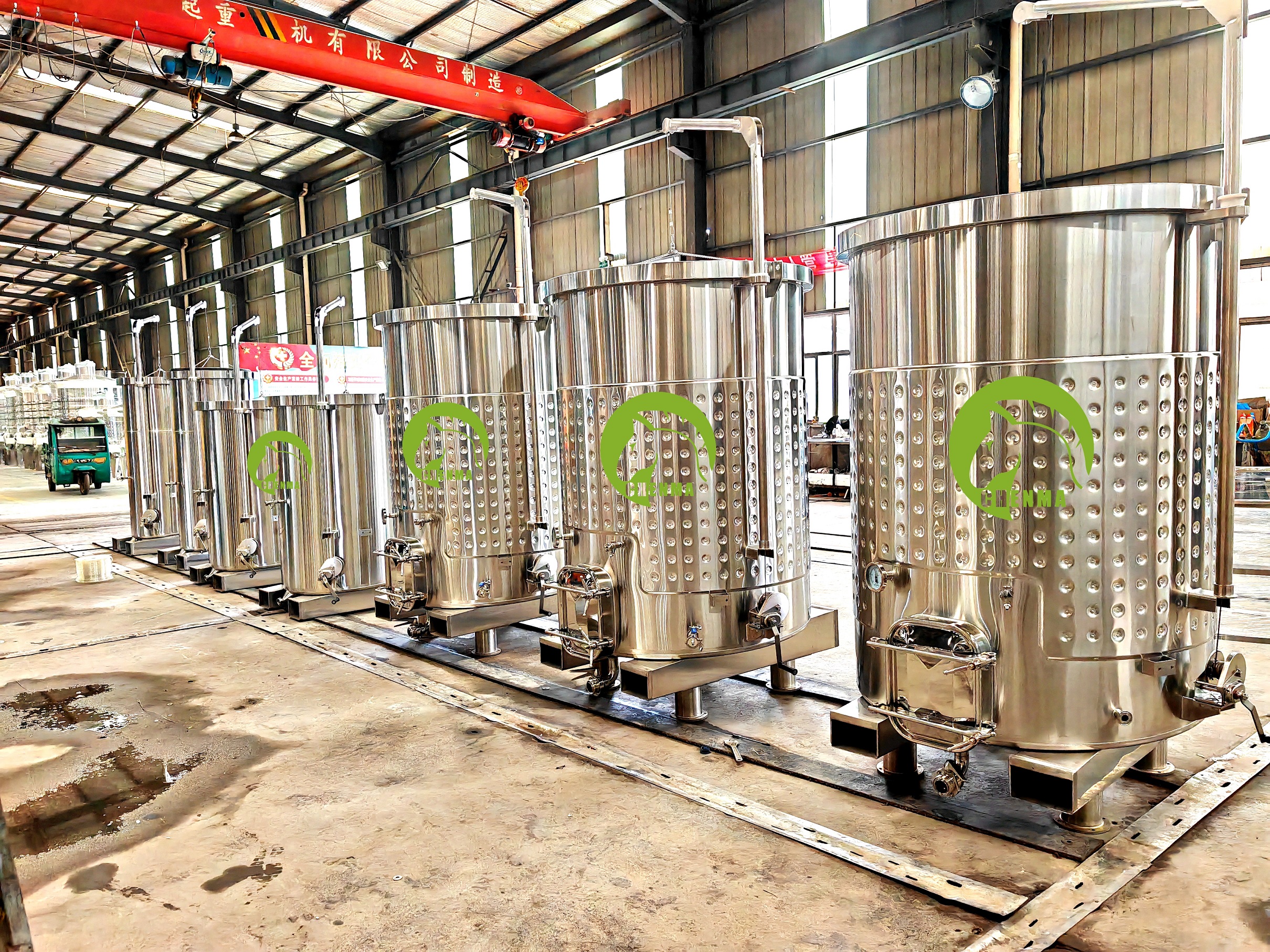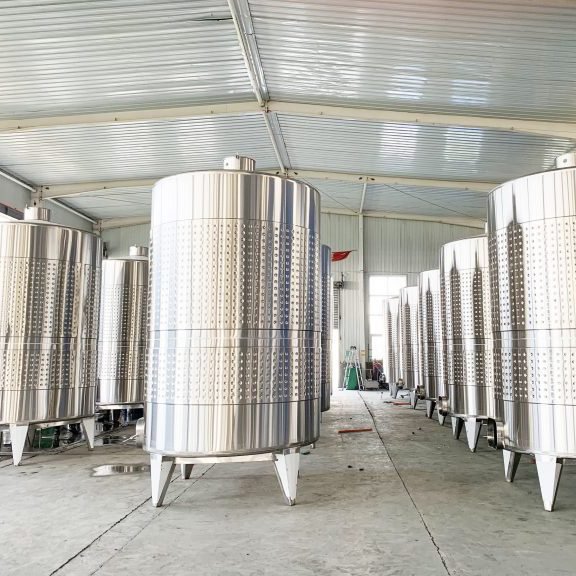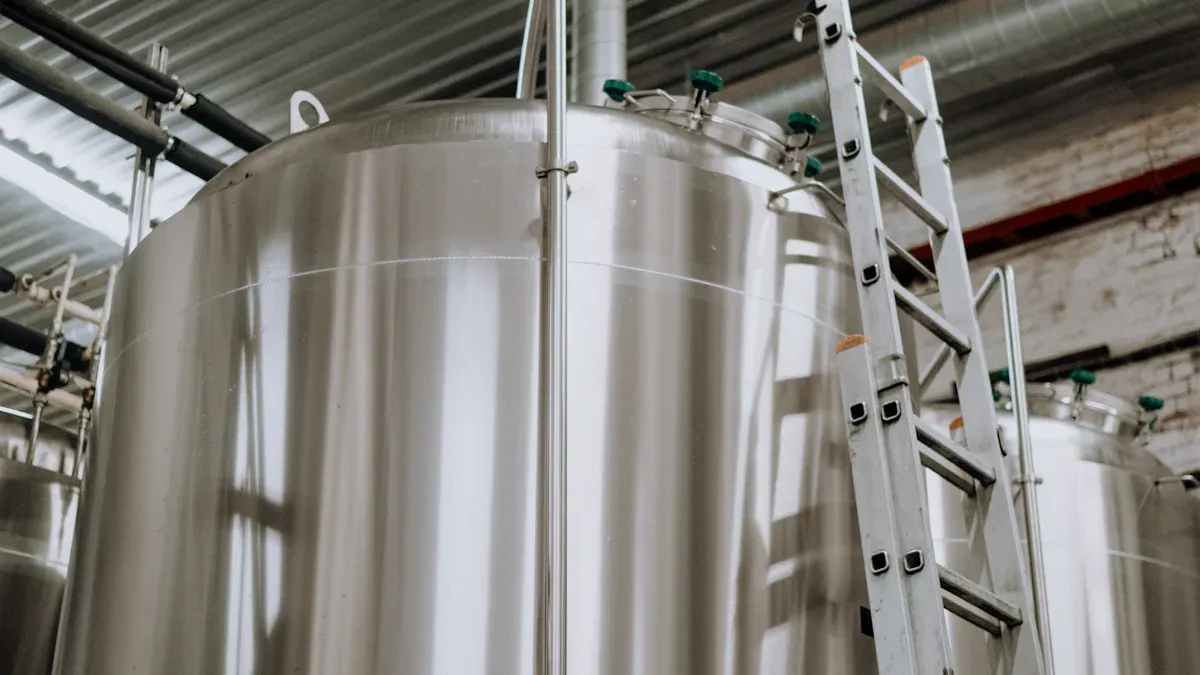
When it comes to fermentation, a stainless steel wine tank transforms the winemaking process into an art of precision. You gain unparalleled control over temperature, ensuring your wine ferments at the perfect pace. These tanks excel at the preservation of freshness, locking in vibrant flavors that make each sip memorable. Their cost-effectiveness also makes them a smart investment, saving you money while delivering consistent quality. With their versatility and low maintenance, you can focus on crafting exceptional wine without unnecessary hassle.
Chenma is one of the professional stainless steel wine tank manufacturers that can provide wineries with a variety of solutions. We also provide cider fermenter、stainless steel oil tank, ect.
Why Stainless Steel Wine Tanks Are Ideal for Fermentation
The role of stainless steel in fermentation efficiency
Stainless steel wine tanks revolutionize fermentation by enhancing efficiency. Their smooth, non-porous surfaces prevent contamination, ensuring your wine retains its authentic character. Grade 316 stainless steel, widely used in bioreactors, demonstrates exceptional performance in fermentation processes. This material supports consistent microbial activity, leading to improved fermentation outcomes. Whether you’re crafting red, white, or sparkling wine, stainless steel tanks for wine production provide the reliability you need to achieve optimal results.
Temperature control benefits of stainless steel tanks
Precise temperature control is vital for successful fermentation, and stainless steel wine tanks excel in this area. Jacketed tanks allow you to regulate temperatures with pinpoint accuracy, maintaining ideal conditions for yeast activity. Studies show that fermentation temperatures in stainless steel containers fluctuate within just 5 °C, compared to a 10 °C increase in underground containers. This stability ensures your wine develops balanced flavors and aromas. Additionally, stainless steel tanks preserve the integrity of acids and esters, enhancing the complexity of your wine.
Oxygen exposure prevention in stainless steel tanks
Oxygen exposure can compromise the quality of your wine, but stainless steel wine tanks offer a solution. Their airtight construction minimizes oxygen ingress, preserving the freshness and vibrancy of your wine. Unlike porous materials, stainless steel does not absorb odors or flavors, ensuring your wine remains true to its intended profile. This structural integrity also prevents unwanted chemical reactions, allowing you to produce wine with consistent quality and taste.
Advantages of Stainless Steel Wine Tanks
Preservation of wine freshness and vibrant flavors
Stainless steel wine tanks excel at preserving the freshness and vibrant flavors of your wine. Their non-porous surfaces create an airtight environment, preventing oxygen from altering the wine’s natural characteristics. This ensures that the characteristic flavor of wine grapes remains intact, delivering a pure and untainted taste.
Scientific studies further highlight this advantage. For instance, research on the aroma profile of Merlot wine stored in stainless steel tanks revealed that these tanks maintain the wine’s original fruity and floral notes. Unlike wooden barrels, which impart woody or spicy aromas, stainless steel tanks allow the wine’s inherent qualities to shine. This makes them ideal for winemakers who prioritize the authentic expression of their grapes.
By choosing stainless steel tanks for wine production, you can confidently craft wines that captivate with their freshness and vibrant flavors, ensuring every bottle reflects the true essence of your vineyard.
Neutral influence on wine flavor profiles
One of the standout benefits of stainless steel wine tanks is their neutral influence on wine flavor profiles. Unlike oak barrels, which impart distinct woody, vanilla, or smoky notes, stainless steel tanks let the wine speak for itself. This neutrality is especially valuable when you want to highlight the characteristic flavor of wine grapes without external interference.
For winemakers producing crisp whites, rosés, or sparkling wines, this neutrality ensures that the wine’s delicate aromas and flavors remain unaltered. Stainless steel’s non-reactive nature also prevents any unwanted chemical interactions, safeguarding the wine’s purity. This allows you to create wines that are true to their varietal and terroir, offering a consistent and authentic experience to your customers.
Durability and long-term cost-effectiveness
The durability of stainless steel wine tanks is unmatched, making them a wise investment for any winery. These tanks boast a long service life, often lasting for decades with minimal maintenance. In contrast, oak barrels require frequent replacements every 3-5 years, significantly increasing long-term costs.
A comparison of stainless steel tanks and oak barrels highlights their cost-effectiveness:
| Aspect | Stainless Steel Tanks | Oak Barrels |
|---|---|---|
| Lifespan | Decades | 3-5 years |
| Maintenance Costs | Low | High (frequent replacements) |
| Initial Investment | Higher | Lower initially |
| Long-term Value | High | Low (due to replacements) |
While the initial investment in stainless steel tanks may be higher, their longevity and low maintenance costs result in substantial savings over time. Additionally, their robust construction ensures they can withstand the demands of large-scale production without compromising performance.
By opting for stainless steel wine tanks, you not only benefit from their durability but also enjoy a cost-effective solution that supports your winery’s growth and sustainability.
Ease of cleaning and maintenance
When it comes to maintaining your winery’s efficiency, stainless steel wine tanks stand out as a game-changer. Their design makes them incredibly easy to clean, saving you time and effort while ensuring top-notch sanitation. The non-porous surface of these tanks prevents residue buildup, so you won’t have to worry about lingering particles affecting the next batch of wine. This smooth surface also resists staining, keeping your tanks looking pristine even after years of use.
Built-in drainage systems further enhance cleaning efficiency. These systems streamline sediment removal, allowing you to clean the tanks thoroughly without unnecessary hassle. Whether you’re dealing with leftover grape skins or yeast sediment, the process becomes quick and straightforward. This ease of cleaning not only reduces labor costs but also ensures that your wine maintains its characteristic flavor of wine grapes without contamination.
By choosing stainless steel tanks, you’re investing in easy maintenance and sanitation. Their durability ensures they remain in excellent condition over time, making them a reliable choice for wineries of all sizes. With these tanks, you can focus on crafting exceptional wine rather than worrying about tedious cleaning routines.
Versatility for different wine types and production scales
Stainless steel tanks for wine production offer unmatched versatility, making them suitable for a wide range of wine styles and production scales. Whether you’re crafting bold reds, crisp whites, or sparkling wines, these tanks adapt seamlessly to your needs. For red wines, their precise temperature control allows you to extract rich flavors, color, and tannins, resulting in a full-bodied product. In white wine production, their airtight design preserves fresh aromas and supports cooler fermentation, enhancing the wine’s delicate character.
These tanks also excel in handling high production volumes. Their robust construction ensures they can withstand the demands of large-scale operations without breaking down. At the same time, they’re equally effective for small-batch production, offering the flexibility to scale up or down as needed. This adaptability makes them an ideal choice for wineries looking to expand their offerings or experiment with new wine styles.
By investing in stainless steel wine tanks, you gain a tool that grows with your business. Their versatility, combined with their easy maintenance and sanitation, ensures you can produce high-quality wine consistently, regardless of your production goals.
Optimal Wine Aging in Stainless Steel Tanks
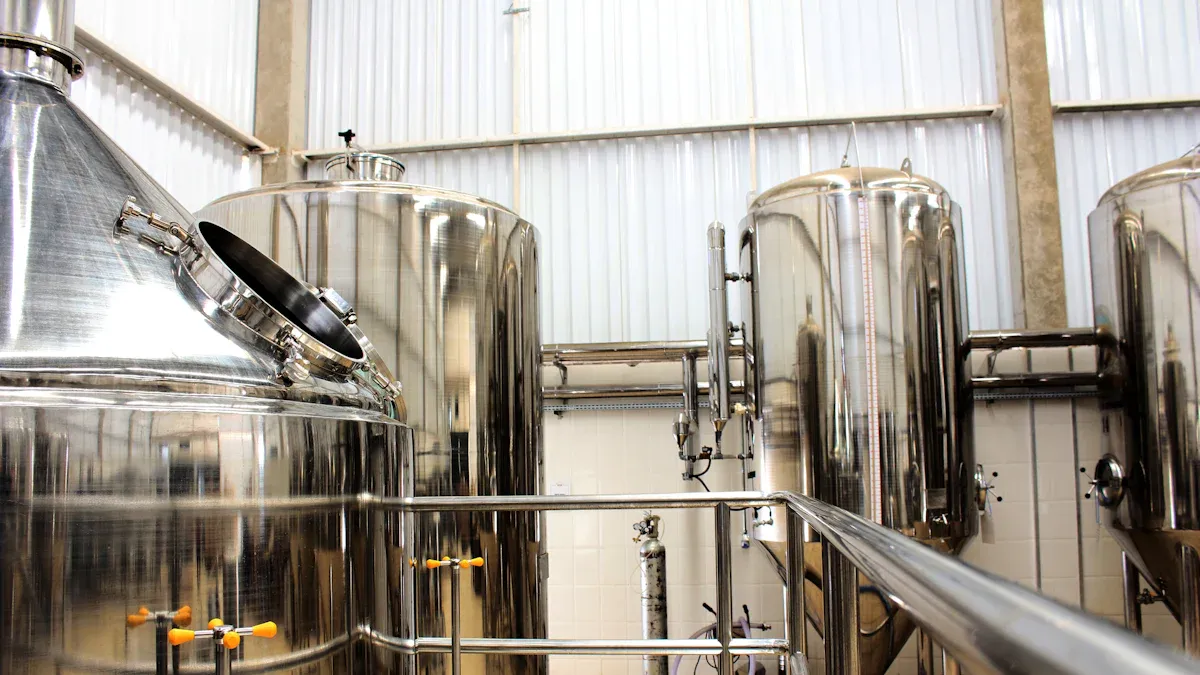
How stainless steel supports controlled aging
Stainless steel wine tanks provide the perfect environment for controlled aging. Their precise temperature regulation ensures that your wine develops its flavors without the risk of undesirable chemical reactions. You can maintain the ideal conditions for aging, allowing the wine to mature gracefully. The airtight design of these tanks minimizes oxygen exposure, which is crucial for preserving the wine’s crispness and vibrant flavor profile.
The non-porous surface of stainless steel plays a key role in maintaining the wine’s freshness. Unlike porous materials, it prevents oxidation, ensuring the wine retains its natural flavors throughout the aging process. Studies have shown that stainless steel tanks can even simulate the effects of wood aging by incorporating techniques like micro-oxygenation and the use of wood chips. This flexibility allows you to achieve the desired aging outcomes while maintaining full control over the process.
Benefits of airtight environments for wine aging
An airtight environment is essential for optimal wine aging in stainless steel tanks. These tanks create a sealed space that reduces oxidation, which can dull the wine’s flavor and compromise its quality. By preserving the wine’s natural acidity and flavor, stainless steel tanks allow the true character of the grapes to shine through.
Unlike oak barrels, stainless steel does not impart external aromas or flavors. This neutrality ensures that the impact of aging on wine flavor remains authentic and unaltered. Whether you’re aging a bold red or a delicate white, the airtight conditions provided by stainless steel tanks help you achieve consistent, high-quality results.
Maintaining wine consistency during aging
Consistency is key when it comes to aging wine, and stainless steel tanks excel in this area. Their durability ensures they maintain stable conditions over time, while their temperature control features prevent overheating or undercooling. This stability supports yeast activity and ensures the wine develops evenly.
The easy-to-clean design of stainless steel tanks also enhances sanitation, reducing the risk of contamination. This ensures that each batch of wine maintains its intended flavor profile. With stainless steel tanks for wine, you can confidently produce wines that reflect the true essence of your vineyard, batch after batch.
Stainless Steel Tanks for Wine vs. Oak Barrels
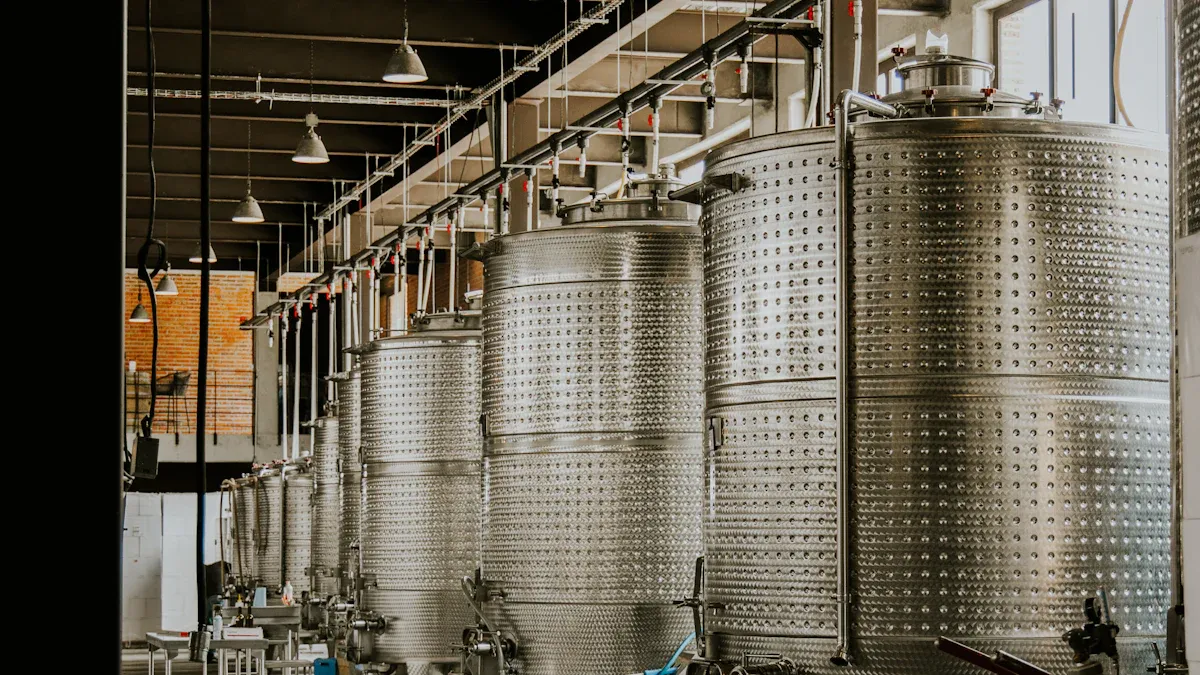
Flavor influence: Neutral vs. oak-derived notes
When it comes to flavor, stainless steel tanks and oak barrels offer distinct advantages depending on your winemaking goals. Stainless steel tanks provide a neutral environment, allowing the natural characteristics of the wine to shine. This is especially beneficial for wines where you want to highlight the grape varietal or terroir. For example, crisp whites and rosés often benefit from the fresh, fruit-forward profile that stainless steel tanks preserve.
In contrast, oak barrels actively influence the wine’s flavor. They impart complex notes such as vanilla, caramel, clove, and smoke, which can add depth and richness to the final product. This makes oak barrels a popular choice for aging bold reds or creamy whites. However, these added flavors can sometimes overshadow the wine’s natural qualities.
| Method | Flavor Profile | Characteristics |
|---|---|---|
| Stainless Steel | Fruit-forward, fresh | Neutral aging, highlights grape varietal, maintains terroir |
| Oak Barrels | Complex, creamy | Adds aromas like vanilla, caramel, and spices, oxygenation benefits |
If you aim to craft wines that express the true essence of your vineyard, stainless steel tanks for wine production are the ideal choice. Their neutrality ensures that nothing interferes with the wine’s authentic flavor.
Oxygen exposure: Controlled vs. porous environments
Oxygen exposure plays a critical role in the aging process, and the choice between stainless steel tanks and oak barrels significantly impacts this. Oak barrels allow for micro-oxidation, a process where small amounts of oxygen interact with the wine. This can soften tannins, enhance mouthfeel, and add complexity to the wine. However, excessive oxygen exposure can lead to oxidation, which dulls flavors and reduces quality.
Stainless steel tanks, on the other hand, are completely airtight. This gives you precise control over oxygen exposure, allowing you to tailor the aging process to your exact specifications. By minimizing oxidation, stainless steel tanks preserve the wine’s freshness and vibrant flavors. This makes them particularly effective for wines that benefit from a crisp, clean profile.
For winemakers seeking consistency and control, stainless steel wine tanks offer a significant advantage. Their airtight design ensures that your wine develops exactly as intended, without the risks associated with porous materials like oak.
Cost comparison: Initial investment vs. long-term savings
The financial aspect of winemaking is just as important as the flavor and aging process. While oak barrels may seem like a more affordable option initially, their short lifespan and high maintenance costs quickly add up. Each barrel can cost up to $2,000 and requires replacement every 2–3 years. Additionally, the labor-intensive cleaning and upkeep further increase expenses.
In contrast, stainless steel tanks represent a more cost-effective solution over time. Although their initial investment is higher, these tanks last for decades—often 30 to 50 years—with minimal maintenance. This durability makes them an excellent choice for wineries looking to maximize their long-term savings.
| Aspect | Oak Barrels | Stainless Steel Tanks |
|---|---|---|
| Lifespan | 3–5 years | 30–50 years |
| Maintenance Effort | High | Low |
| Replacement Frequency | Frequent | Rare |
By choosing stainless steel tanks, you’re not just investing in a product—you’re investing in the future of your winery. Their longevity and low maintenance requirements make them a smart financial decision for both small-scale and large-scale production.
Maintenance: Ease of cleaning vs. labor-intensive care
Maintaining your winemaking equipment can be a time-consuming and costly process, but stainless steel wine tanks simplify this task significantly. Their smooth, non-porous surfaces make them easy to clean, saving you both time and effort. Unlike oak barrels, which absorb residues and require labor-intensive scrubbing, stainless steel tanks allow you to focus on crafting exceptional wine rather than worrying about tedious maintenance routines.
Why Stainless Steel Tanks Are Easier to Maintain
- Lower Cleaning Frequency: Stainless steel tanks need cleaning less often than oak barrels, which demand regular attention to prevent contamination.
- Smooth Surface Advantage: The non-porous surface prevents residue buildup, ensuring that leftover particles from previous batches don’t affect the next one.
- Durability: Stainless steel tanks last for decades, while oak barrels typically need replacement every three to five years. This longevity reduces the need for frequent inspections and repairs.
Proper cleaning of stainless steel tanks not only preserves wine quality but also extends the lifespan of your equipment. Regular cleaning and occasional passivation strengthen the tank’s protective layer, ensuring it withstands the acidity of wine during fermentation and aging.
Comparing Maintenance Costs
The cost of maintaining oak barrels quickly adds up due to their short lifespan and high labor requirements. Stainless steel tanks, on the other hand, offer a cost-effective solution. Here’s a quick comparison:
| Aspect | Stainless Steel Tanks | Oak Barrels |
|---|---|---|
| Cleaning Frequency | Low | High |
| Maintenance Effort | Minimal | Labor-intensive |
| Replacement Frequency | Rare (30–50 years lifespan) | Frequent (3–5 years lifespan) |
| Cost Over Time | Cost-effective | Expensive |
By choosing stainless steel tanks for wine production, you reduce maintenance costs and labor demands while ensuring your wine remains uncontaminated and true to its flavor.
The Role of Regular Inspections
Even though stainless steel tanks are easy to clean, regular inspections are essential to maintain their performance. These checks help you identify potential issues, such as minor scratches or dents, before they escalate. Inspections also ensure that the tanks remain airtight, which is crucial for controlling oxidation during aging.
With stainless steel wine tanks, you gain a reliable and low-maintenance solution that supports your winemaking goals. Their ease of cleaning, combined with their durability, makes them an invaluable asset for wineries of all sizes.
Environmental Benefits of Stainless Steel Wine Tanks
Sustainability and reusability of stainless steel tanks
When you choose a stainless steel wine tank, you’re making a sustainable choice that benefits both your winery and the planet. Stainless steel is one of the most recyclable materials in the world. Its durability ensures that tanks can be reused for decades without losing their quality. This reduces the need for frequent replacements, saving resources and lowering waste.
Life-cycle assessments highlight the environmental advantages of stainless steel tanks. For example, using these tanks can reduce steel consumption by 110 metric tons and HDPE plastic consumption by 82 metric tons. Greenhouse gas emissions drop by 867 kilograms of CO2, while water consumption decreases by 9,443 cubic meters. These reductions significantly lower the overall environmental impact, including global warming potential and energy demand.
By investing in stainless steel tanks, you’re not just improving your winemaking process. You’re also contributing to a more sustainable future.
Reduced reliance on natural resources like oak
Stainless steel tanks help you reduce dependence on natural resources such as oak. Oak barrels require trees to be cut down, which impacts forests and ecosystems. In contrast, stainless steel is a manufactured material that doesn’t rely on deforestation. This makes it a more eco-friendly option for wineries focused on sustainability.
Additionally, oak barrels have a limited lifespan and need frequent replacement. Stainless steel tanks, however, last for decades, reducing the demand for raw materials. By choosing stainless steel, you’re helping to preserve natural resources for future generations.
Lower environmental impact over time
The long lifespan of stainless steel tanks ensures a lower environmental footprint over time. Unlike oak barrels, which degrade and require disposal, stainless steel tanks remain functional for decades. Their reusability minimizes waste and reduces the need for energy-intensive manufacturing processes.
Moreover, the airtight design of stainless steel tanks supports efficient wine aging without the need for additional materials like wax or sealants. This further reduces their environmental impact. By opting for stainless steel, you’re aligning your winery with eco-conscious practices that benefit both your business and the environment.
Tips for Choosing the Right Stainless Steel Wine Tank
Selecting the appropriate tank size for production needs
Choosing the right tank size is crucial for efficient wine production. Your production scale determines the ideal tank size. For small-scale operations, such as homebrewing or micro-batches, tanks with a capacity of 6 to 10 gallons work best. These smaller tanks allow you to experiment with recipes while maintaining manageability.
If you’re running a pilot or small-scale commercial winery, tanks ranging from 20 to 200 gallons are more suitable. These sizes help you step up production while testing new blends. For large-scale commercial wineries, tanks with capacities of 200 to 5,000 gallons or more are essential. They ensure consistency and efficiency in high-volume production.
| Production Scale | Common Vessels | Focus |
|---|---|---|
| Homebrew / Micro Batch (1-10 Gallons) | 6 gallon / 6.5 gallon plastic buckets, glass carboys | Manageability, experimentation |
| Pilot / Small Scale Commercial (20 – 200 Gallons) | Smaller stainless steel fermenters, 60 gallons tanks (approx. 1 barrel), plastic carboys (larger sizes) | Stepping up production, testing recipes |
| Commercial Winery / Brewpub (200 – 5000+ Gallons) | Various sizes of stainless steel tanks, potentially including open top and variable capacity tanks | Efficiency, consistency, volume production |
By selecting the right tank size, you can optimize your production process and ensure your stainless steel wine tank meets your specific needs.
Evaluating temperature control features
Temperature control plays a vital role in crafting high-quality wine. When choosing the best wine stainless steel tanks, look for features like built-in cooling jackets and insulation. Cooling jackets regulate fermentation temperatures, preventing overheating. Insulation reduces energy consumption and keeps the temperature stable.
Precision temperature control is another key feature. It allows you to set specific temperatures, ensuring consistent fermentation and aging. This precision helps preserve the wine’s flavor and aroma, giving you a competitive edge in the market.
| Feature | Benefit |
|---|---|
| Built-in cooling jackets | Regulate temperature effectively, preventing overheating. |
| Insulation | Reduces energy use and keeps fermentation temperatures stable. |
| Precision temperature control | Allows specific settings for consistent, high-quality wine production. |
By prioritizing these features, you can maintain the perfect conditions for your wine, ensuring every batch meets your quality standards.
Assessing budget and long-term investment
Investing in a stainless steel wine tank requires careful budget planning. While the initial cost may seem high, the long-term savings make it worthwhile. Stainless steel tanks last for decades, reducing replacement costs. Their durability and low maintenance needs also minimize ongoing expenses.
Consider the cost-effectiveness of these tanks compared to alternatives like oak barrels. Oak barrels require frequent replacements and labor-intensive care, which increases costs over time. Stainless steel tanks, on the other hand, offer a one-time investment with lasting benefits.
| Advantage | Description |
|---|---|
| Corrosion resistance | Stainless steel effectively resists corrosion from acidic substances produced during fermentation. |
| Easy to clean and disinfect | The smooth surface allows for quick and effective cleaning, reducing the risk of cross-contamination. |
| Good sealing | High-quality seals prevent oxygen and contaminants from entering, maintaining product quality. |
| Customization and adaptability | Tanks can be tailored to specific brewing needs, allowing for flexibility in production. |
By assessing your budget and focusing on long-term value, you can make a smart investment that supports your winery’s growth and sustainability.
Compatibility with specific wine styles
A stainless steel wine tank offers unmatched versatility, making it an excellent choice for crafting a wide variety of wine styles. Whether you specialize in bold reds, crisp whites, or sparkling wines, these tanks adapt seamlessly to your production goals. Their ability to maintain precise temperature control and provide an airtight environment ensures that each wine develops its unique character without compromise.
For red wines, stainless steel tanks allow you to extract deep flavors, vibrant colors, and balanced tannins. This makes them ideal for producing full-bodied wines that captivate the palate. If you focus on white wines, these tanks preserve delicate aromas and fresh acidity, ensuring a clean and refreshing finish. Sparkling wine producers also benefit from the tanks’ ability to handle high-pressure fermentation, delivering consistent quality with every batch.
The adaptability of stainless steel tanks extends to experimental winemaking. You can easily adjust fermentation conditions to explore new blends or techniques. This flexibility empowers you to innovate while maintaining control over the process.
By choosing a stainless steel wine tank, you gain a tool that supports your creativity and enhances the quality of your wines. Its versatility ensures that no matter your style, you can craft wines that reflect your vision and delight your customers.
Common Misconceptions About Stainless Steel Wine Tanks
Addressing concerns about flavor neutrality
You might have heard that stainless steel wine tanks lack the ability to enhance flavors. This misconception often stems from comparing them to oak barrels, which impart distinct woody or spicy notes. However, the neutrality of stainless steel is actually a strength. It allows the natural flavors of your wine to shine without interference. If you want to highlight the unique characteristics of your grapes or terroir, a stainless steel wine tank is your best ally. This approach ensures your wine delivers an authentic and unaltered taste that resonates with your customers.
Debunking myths about cost and durability
Some believe stainless steel tanks are too expensive or fragile for long-term use. This couldn’t be further from the truth. While the initial investment may seem higher, these tanks last for decades with minimal maintenance. Their durability far surpasses that of oak barrels, which require frequent replacements. Additionally, stainless steel resists corrosion and wear, making it a cost-effective solution for wineries of all sizes. By choosing stainless steel, you’re not just saving money—you’re investing in a reliable tool that supports your winemaking goals for years to come.
Clarifying their role in premium winemaking
Another common myth is that stainless steel tanks are only suitable for mass production or lower-quality wines. In reality, many premium wineries rely on stainless steel to craft exceptional products. These tanks provide precise temperature control and an airtight environment, both of which are essential for producing high-quality wine. Whether you’re creating a crisp white or a bold red, stainless steel ensures consistency and excellence in every batch. By embracing this technology, you can elevate your winemaking process and deliver wines that stand out in the market.
Real-World Applications of Stainless Steel Tanks in Winemaking
Case studies of wineries using stainless steel tanks
Many wineries have transformed their production processes by adopting stainless steel wine tanks. For example, a boutique winery in California switched from oak barrels to stainless steel tanks to produce crisp white wines. The tanks allowed precise temperature control during fermentation, preserving the delicate floral and fruity notes of their Chardonnay. As a result, the winery saw a 20% increase in customer satisfaction ratings for its white wine collection.
In France, a large-scale winery specializing in sparkling wines leveraged stainless steel tanks to handle high-pressure fermentation. The tanks’ airtight design ensured consistent carbonation levels, leading to a 15% boost in production efficiency. These case studies highlight how stainless steel tanks adapt to diverse winemaking needs, whether for small batches or large-scale operations.
Success stories of improved wine quality and efficiency
Winemakers worldwide have reported significant improvements in wine quality and production efficiency after adopting stainless steel tanks. A New Zealand winery specializing in Sauvignon Blanc noted that the tanks preserved the wine’s vibrant acidity and tropical fruit flavors. This resulted in higher scores from wine critics and increased sales in international markets.
Efficiency gains are equally impressive. A winery in Australia reduced fermentation time by 30% thanks to the tanks’ precise temperature control. This allowed them to produce more wine without compromising quality. The smooth surfaces of the tanks also simplified cleaning, cutting labor costs by 40%. These success stories demonstrate how stainless steel tanks enhance both the quality of your wine and the efficiency of your operations.
Chenma Machinery’s contributions to stainless steel tank innovation
Chenma Machinery leads the industry in stainless steel tank innovation. Their state-of-the-art production facility in Shandong Province manufactures tanks tailored to your unique winemaking needs. With over 200 skilled professionals and advanced machinery, Chenma creates tanks that meet the highest safety and quality standards, including ISO9001 and EU CE certifications.
Chenma’s tanks feature cutting-edge designs, such as built-in cooling jackets for precise temperature control and customizable capacities for different production scales. Their engineers work closely with you to develop solutions that align with your goals, whether you’re crafting bold reds or delicate whites. By choosing Chenma, you gain access to tanks that elevate your wine’s quality and streamline your production process.
Tip: Partnering with Chenma Machinery ensures you invest in stainless steel tanks that deliver long-term value and exceptional results for your winery.
Choosing a stainless steel wine tank transforms your winemaking process into a precise and efficient craft. These tanks offer unmatched durability, hygiene, and flavor retention. Unlike plastic, they resist dents, scratches, and contamination risks, ensuring your wine maintains its authentic taste. Their versatility makes them ideal for both small-scale and large-scale production, giving you the flexibility to grow your business.
| Feature | Stainless Steel | Plastic |
|---|---|---|
| Durability | Highly durable; resists dents and scratches | Prone to cracking |
| Hygiene | Easy to clean and sanitize | Harder to sterilize |
| Flavor Retention | Non-porous; no absorption of flavors or odors | Absorbs flavors and odors |
By investing in these tanks, you gain precise temperature control and long-term cost savings. Partnering with trusted suppliers like Chenma Machinery ensures you receive tanks tailored to your needs. Take the next step in elevating your wine production and secure a solution that guarantees quality and sustainability.
FAQ
What makes stainless steel wine tanks better than oak barrels?
Stainless steel tanks offer unmatched durability, precise temperature control, and a neutral flavor profile. They preserve the wine’s natural characteristics, unlike oak barrels, which add woody notes. Their long lifespan and low maintenance make them a cost-effective choice for wineries of all sizes.
Are stainless steel wine tanks suitable for small-scale wineries?
Absolutely! Stainless steel tanks come in various sizes, making them perfect for small-scale production. Their versatility allows you to experiment with different wine styles while maintaining consistent quality. You can scale up production as your winery grows without needing to replace your tanks.
How do stainless steel tanks help with temperature control?
Stainless steel tanks feature built-in cooling jackets and insulation. These components allow you to regulate fermentation temperatures with precision. This ensures yeast activity remains optimal, resulting in balanced flavors and aromas. Consistent temperature control also prevents overheating, which can compromise wine quality.
Do stainless steel tanks affect the flavor of wine?
No, stainless steel tanks have a neutral influence on wine flavor. They don’t impart external aromas or tastes, allowing the wine’s natural characteristics to shine. This makes them ideal for winemakers who want to highlight the grape varietal and terroir without interference.
Are stainless steel wine tanks environmentally friendly?
Yes! Stainless steel is highly recyclable and lasts for decades, reducing waste. Unlike oak barrels, which rely on deforestation, stainless steel tanks minimize the use of natural resources. Their long lifespan and reusability make them a sustainable choice for eco-conscious wineries.
Tip: Investing in stainless steel tanks not only benefits your winery but also supports a greener planet. 🌍

